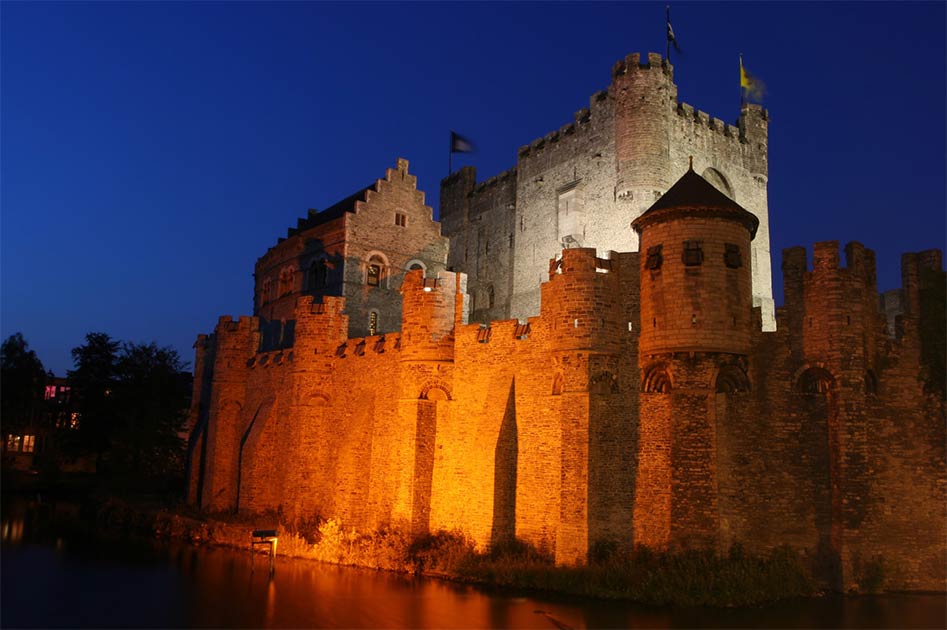Gravensteen Castle: Site of Gruesome Torture and Revolting Students
The historic region of Flanders in Belgium is famous for its many medieval monuments and buildings. These relics date back to an era when the region was a major economic and political center under the Counts of Flanders. For many years Gravensteen, a massive Gothic castle, was the heart of the region. Today, this restored fortress is one of the most famous historic sites in all the region.
The Gory History of Gravensteen Castle in Ghent
The Counts of Flanders dominated the region for most of the Middle Ages. In the 9 th century AD, Baldwin II built a wooden fortress on the site of the current castle, constructed to defend the area from the Vikings. In c. 1180, the castle burned down, presumably by accident.
The Counts rebuilt their stronghold in stone in the Gothic style and it is thought to have been completed in the reign of Count Phillip of Alsace. The fortress was based on castles that had been built in the Crusader states, in what is now Israel and Lebanon. The bastion was built in part to pacify the wealthy and ever-restive citizens of Ghent, who often resisted the rule of the Counts of Flanders.

The walkways and walls of Gravensteen Castle in Ghent, Belgium (Sergey Kelin / Adobe Stock)
From 1180 to the 1350s the castle was the official residence of the Counts of Flanders, who lived in great opulence and luxury. When the Counts moved to a new residence in the late 14 th century, the castle remained an important military site and was also used as a prison by the Council of Flanders.
Prisoners were interrogated in the fortress and many of them were tortured. In the donjon, the innermost keep beneath the fortress, captives suffered gruesome torments even by the standards of the Middle Ages. Some were stretched on the rack and had water poured down their throats via a funnel until they swelled.
People who were mentally ill were also subjected to horrendous abuses, such as having a pear-shaped wooden ball placed in their mouth, secured with a rope around their head, to prevent them from making noise.

Water and rack in the torture museum in the Castle of the Counts, Ghent, Belgium (CC by SA 2.0)
When the city of Ghent took over Gravensteen it initially became the municipal mint. During the early 19 th century, the castle was turned into a cotton mill, but by the late 19 th century, Gravensteen was dilapidated and scheduled for demolition. Thankfully the local municipality chose to restore the medieval fortress authentically under the direction of the architect Joseph de Waele.
Ghent hosted the World Fair in 1913 and the castle was one of the main attractions. In 1949 students stormed the castle and pelted the authorities with rotten fruit in protest of a new tax on beer. They were not successful.
Gravensteen Castle, a Gothic Gem
Gravensteen is a motte castle surrounded by water which was diverted from the River Lys. It is located on a rise with the main entrance via a bridge. The main gateway is up narrow and winding stairs.
- Modern Comfort and Traditional Opulence, The Perfect Combination in Peleș Castle
- Medieval Torture: The Terrifying Threat of Twisting off Limbs and Burning Flesh
- Skeletons in the Closet: Walls of Bones Discovered Beneath Cathedral

The former chapel in Castle Gravensteen (bbsferrari / Adobe Stock)
The gatehouse is beautifully preserved, as are the walls’ ramparts which are up to 60 feet high (20 m) with many oval battlements and towers. In total there are two dozen turret towers on the ramparts, and it is possible to walk the full extent of the walls to enjoy the views of the beautiful city of Ghent.
At the heart of the fortress is the keep with its gruesome donjon. This massive rectangular structure was once the private residence of the Count of Flanders. Adjacent to the keep the Lord’s Hall, now completely restored, is where once the Count of Flanders held court. The halls and chambers beneath the castle are now used as a number of museums, such as the arms museum where armor and military memorabilia can be seen. The most popular part of the castle is the Torture Museum, where small children and those with a weak stomach are not encouraged to visit.

View of Ghent from the top of the Gravensteen Castle, Belgium (woojin / Adobe Stock)
Visiting Gravensteen Castle in Ghent, Belgium
The castle is located in the heart of Ghent. A fee is charged to enter the castle where there are a great many exhibitions and several fun things to do. All areas are accessible and the views from the walls are not to be missed. An audio guide is available to visitors in various languages, which provides information on the castle as you explore.
Top image: Gravensteen Castle in Ghent, Belgium Source: Kurt De Bruyn / Adobe Stock
By Ed Whelan
References
De Vries, A. (2007). Flanders: a cultural history. Oxford University Press
Laleman, M. C. (2013). Ghent (East Flanders, Belgium) in the Discussion about Early Towns and Artisan Production. Medieval and Modern Matters, 4, 109-118
Available at: https://www.brepolsonline.net/doi/abs/10.1484/J.MMM.5.109772
Lepage, J. D. G. (2010). Castles and fortified cities of Medieval Europe: an illustrated history. McFarland



















